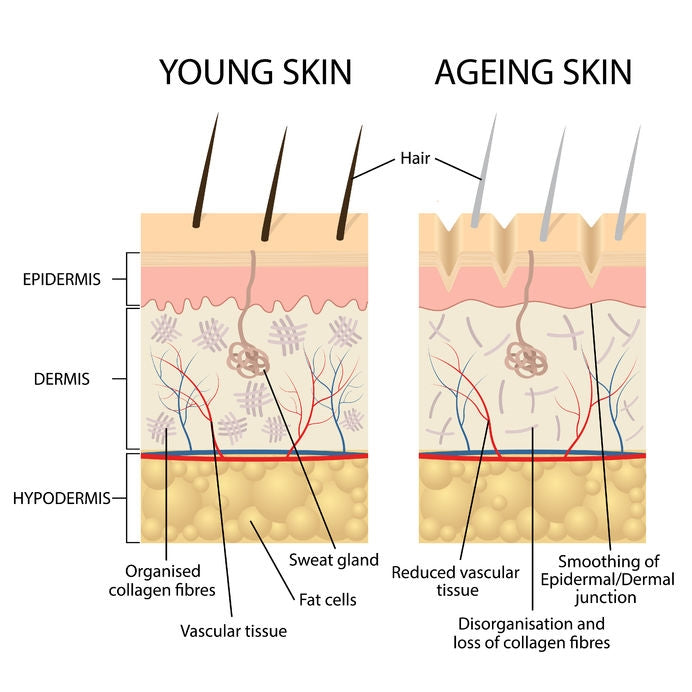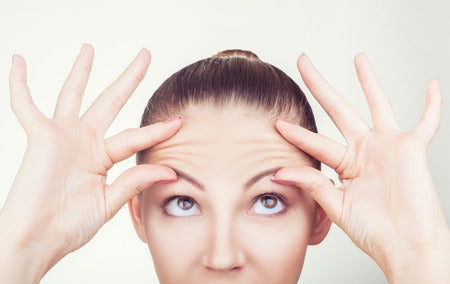Blog
Gluten Skin and Your Health. This is What You Need to Know
A while ago we wrote about ‘Gluten Face’ (yes it’s a thing!) and now, let’s look at the relationship between gluten skin and your health. Learn more below! Shop All Apothekari Is Gluten Really Bad for You? Over the past few years, gluten has taken a real bashing when it comes to your health. A protein found in grains like wheat, rye and barley, it also can turn up in other foods, through cross contamination. (ie, other grains like oats). Know why we love bread so much? Yup, gluten. It gives baked goods their chewy deliciousness. It may taste great, but sadly, eating it may not be so good for some people. Not so serious, is gluten intolerance, which comes with a long range of symptoms when gluten-containing foods are consumed. Far more serious is Celiac Disease, a genetic, autoimmune condition, that occurs in people where eating gluten leads to damage in the small intestine. Nutrients can’t be absorbed properly into the body and long-term health complications follow, including: Iron deficiency anemia Early onset osteoporosis or osteopenia Infertility and miscarriage Lactose intolerance Vitamin and mineral deficiencies Nervous system disorders Gastrointestinal cancers Neurological issues including epileptic seizures, dementia, migraine, etc Gluten Skin Implications You Should Know About Whether you’re gluten intolerant or have Celiac Disease, the symptoms may be the same. And some individuals, especially those with Celiac Disease, may have no symptoms at all: Digestive issues such as gas, abdominal pain, cramping, bloating, constipation or diarrhea. Ongoing low energy levels, “brain fog,” chronic fatigue syndrome or fibromyalgia. Autoimmune disease such as Hashimoto’s thyroiditis, rheumatoid arthritis, ulcerative colitis, lupus, psoriasis, scleroderma or multiple sclerosis. Neurologic symptoms such as dizziness or feeling off balance. Hormone imbalances such as PMS, PCOS, delayed menstruation onset and stunted growth. Migraines and/or frequent headaches. Joint pain, inflammation and swelling, particularly in fingers, knees or hips Gluten skin issues include eczema, rosacea, skin rashes, psoriasis and keratosis pilaris (also known as ‘chicken skin’ on the back of your arms). Avoid Gluten in Skincare? Should you avoid gluten in your skincare products if you’re intolerant or have Celiac Disease? The answer may surprise you. Turns out that applying vs ingesting gluten, are two very different things. According to Dr. Alessio Fasano, Medical Director of the Center for Celiac Research, University of Maryland, “If you have Celiac Disease, then the application of gluten containing products to the skin should not be a problem, unless you have skin lesions that allow gluten to be absorbed systemically in great quantities.” This advice can be carried over to lipstick and lip products, as they are easily ingested. Last, if you have active dermatitis herpetiformis, a skin condition associated with Celiac Disease, or any cuts or open lesion, then use gluten-free skincare products to prevent its absorption. One caveat: If you have skin issues that won’t clear up no matter what you do, cut out gluten containing skincare products to see if it may help. The following Apothekari products don’t contain any gluten: Glow Getter 3, AHA-Mazing Clean Exfoliating Cleanser, Daily Infusion Moisturizer, Natural Deodorants. They are not certified gluten free. Should You Follow A Gluten Free Diet? Following a gluten free diet is essential if you’ve tested positive for Celiac Disease. It’s not the same with gluten intolerance. Consumption doesn’t carry the same long-term health implications, but you’ll likely feel better if you avoid or restrict it in your diet. I’ve heard ‘experts’ suggest that you shouldn’t go gluten free unless you have Celiac Disease because a gluten free diet is expensive and that you’re going to load up on gluten free crackers, cookies and cakes. To which I say, REALLY? I don’t know about you, but if I’m switching up my diet because of my health, it’s highly unlikely I’ll be loading up on Cheetos. In my family, we have two gluten intolerant individuals. And no, IT.IS.NOT.IN.THEIR.HEADS! Following a gluten free diet is essential to their wellbeing and as the primary food shopper and cook in our house, I’ve learned how to prepare nourishing and delicious meals. Focus on foods that are naturally gluten free, which also tend to be great for your overall wellness: Meat, poultry, and eggs Fish and seafood Beans and legumes Fruits and vegetables Grains and starches including, corn, rice, buckwheat, millet, tapioca, oats (ensure not contaminate) Nuts Dairy Potatoes Vinegars and oils Herbs and spices Gluten Skin & Health Resources You know yourself best so if you need to go gluten free for your health, do it. And, don’t let anyone question why. Check in with a trusted healthcare professional if you need guidance. And, visit the many trustworthy resources online. Here are some to get you started: National Celiac Organization. A non-profit organization dedicated to educating and advocating for individuals with celiac disease and non-celiac gluten sensitivities, Celiac Disease Foundation. (CDF) is a nonprofit that helps fund research, education, and advocacy programs. Learn more about celiac disease and how to live gluten free. NIH. National Institutes of Health link to help you start on your GF journey US FDA. Information to help you read food labels. Gluten Intolearnce Group. Information for individuals with a gluten sensitivity. The Inspired RD. Alysa Bajenaru, a Registered Dietitian’s blog on navigating Celiac Disease. Great recipe inspiration.
Learn moreAging Skin: 7 Things That Can Happen
Aging skin – it’s one of those unavoidable side effects of getting older. While we likely appreciate the wisdom, experience and sense of accomplishment that come with age, we may not necessarily applaud what looks back at us in the mirror. Shop Apothekari Ageless Skin Set Our skin ages in one of two ways – intrinsically or extrinsically. Intrinsic aging is the natural process that takes place over the years regardless of outside influences. Our genetic make-up, hormonal and metabolic processes account for intrinsic aging. Extrinsic aging occurs due to external factors such as sun exposure and environmental damage (pollution and smoking, for example). While we can’t necessarily control intrinsic aging, we can generally minimize the impact of extrinsic factors. Aging Skin Symptoms Aging skin tends to appear: Thinner and more transparent Slacker (saggier and looser) More fragile and more prone to damage (bruising) due to thinner blood vessel walls Drier Wrinkled Duller Rougher Unevenly toned. With age spots and possibly lesions. Different in shape In this blog post let’s look at the ways in which skin ages so that in part 2, we can visit some specific strategies to help keep your aging skin looking its very best. 1. Changes in the Epidermis This outer barrier of our skin protects us from environmental insults, such as bacteria and ultraviolet (UV) radiation. Due to the natural aging process and sun exposure, changes occur. The most obvious one occurs at the epidermaldermal junction – the space between the epidermis and the dermis – where a flattening of ridges occurs. This results in less surface contact of the epidermis and dermis and leads to a reduced exchange of nutrients between these two parts. Aging skin doesn’t get as much nourishment. 2. Changes in the Dermis The dermis sits under the epidermis and contains a very complex arrangement of proteins, including collagen and elastin, which are responsible for skin’s strength and elasticity. Fibroblasts (skin cells) start producing fewer proteins: Elastin, which gives our skin elasticity and rebound. The result is sag. Collagen, which gives our skin firmness contributing to a significant reduction in elasticity. The result is thinner more fragile skin. Glycosaminoglycans (GAGs), which help to keep skin hydrated. The result is more dryness. And, there are fewer Blood Vessels, resulting in less blood volume and leaving the area deficient in nutrients. 3. Changes in Fat Tissue The subcutaneous fatty layer (also called the hypodermis) below the skin starts to shrinks, resulting in sagging. Fat is depleted and accumulates in areas including the forehead, the mouth, the eyes, the nose, the jaws and the cheeks. In young skin, fat tissue is widely distributed, but in aged skin fat tends to accumulate in pockets, which droop and sag due to the force of gravity. 4. Hormonal Slowdown A decline in hormone production including estrogen, testosterone and dehydroepiandrosterone (DHEA) occurs. Other hormones such as melatonin, insulin, cortisol, thyroxine, and growth hormone decline too. Certain signaling molecules such as cytokines and chemokines decline as well, leading to the deterioration of several skin functions. Estrogen and progesterone are thought to contribute to skin elasticity. 5. Gravity Over time, gravity plays a role resulting in an altered distribution of fat, which contributes to sagging. This is particularly prominent in the upper and lower eyelids, on the cheeks, and in the neck region. gravity causes drooping of the eyebrows and eyelids, looseness and fullness under the cheeks and jaw (jowls and “double chin”), and longer ear lobes. 6. Facial Bones and Cartilage Expression lines appear as result of repeated facial muscle movement especially over the forehead and between eyebrows, and in nasolabial folds and eye areas. Repeated folding of the skin during sleeping in the same position on the side of the face contributes to appearance of “sleeping lines.” Bone mass declines and enhances the appearance of facial sagging and wrinkling. 7. Extrinsic Aging Possibly the biggest factor in aging skin is the impact of sun and environmental damage (tobacco use and exposure to pollution, for example), diet and lifestyle factors. These contribute to skin thickening, freckles and sun spots and possibly precancerous changes such as lesions called actinic keratosis and skin cancer (including basal cell carcinoma, squamous cell carcinoma, lentigo maligna melanoma). Over time, the sun’s ultraviolet (UV) light damages elastin, collagen and GAGs which causes the skin to sag, stretch, and lose its ability to snap back after stretching. The skin also becomes drier, bruises and tears more easily and takes longer to heal. The impact of sun damage may not show when you’re young, but it will later in life. As of yet, no one has found an answer to stopping the skin’s natural aging process. But rest assured, science has given us a few tools to counteract its impact. Yes, aging skin is an inevitable process but by starting to take care of your skin at an early age you can help to minimize the damage. All is not lost. In part 2, let’s take a look at this.
Learn moreForehead Wrinkles - Here's What To Do
Forehead wrinkles – or other kinds of wrinkles for that matter, are wrinkles, are wrinkles, are wrinkles! Forehead wrinkles are a natural, if unfortunate, sign of aging, and just like the wrinkles you may develop on your face or around your eyes, it’s hard to escape from them as time goes by. They are a result of sun damage, repetitive movements and aging. If you are someone who is troubled by the appearance of your forehead wrinkles or want to slow down their development as much as possible, there are number of steps you can take to reduce their impact on how you look: SHOP RADIANT SKIN SET Wear Sunscreen. A well formulated UVA/UVB broad spectrum sunscreen with a minimum SPF of 30, will help to fight against the sun’s damaging rays. UV rays break down collagen and elastin, which help skin maintain its structural integrity in fighting against the development of wrinkles. Wearing sunscreen is a must to help prevent the development of forehead wrinkles in the first place. Add in Antioxidants. Ingredients including Vitamins A and C, coenzyme Q10, alpha lipoic acid and green tea can help to fend off free radical damage, which is generated by exposure to the sun and pollution. Free radicals are unstable molecules which can cause havoc in skin and contribute to wrinkles, whether on your forehead or anywhere else. Apply Collagen Boosters. Skin care actives like retinoids increase skin cell turnover, which decreases as we age. These ingredients also ‘tell’ old skin cells to behave like healthier younger ones, helping to boost the production of collagen, giving skin a more youthful appearance. We like Apothekari A is for Anti-Aging, which boasts gentle and effective retinaldehyde plus a host of additional skin beneficial ingredients to exfoliate, brighten and protect. Seek Medical Intervention. If you’ve tried topical treatments and are still not pleased with the results, you may want to consult a trained medical professional to discuss options including laser, dermabrasion, Botox or facial surgery. These procedures can come with a hefty price tag, but if you are after faster and more visible results, they are worth considering. What NOT to do? Don’t fall for exercises that claim to tone or strengthen facial muscles. These exercises are often series of repetitive motions, which will in fact, contribute to the development of wrinkles and not reduce them. Instead, focus on relaxing your facial muscles so that your forehead doesn’t move as much. It’s difficult and requires a lot of concentration, but with focus and attention, it is possible.
Learn more



